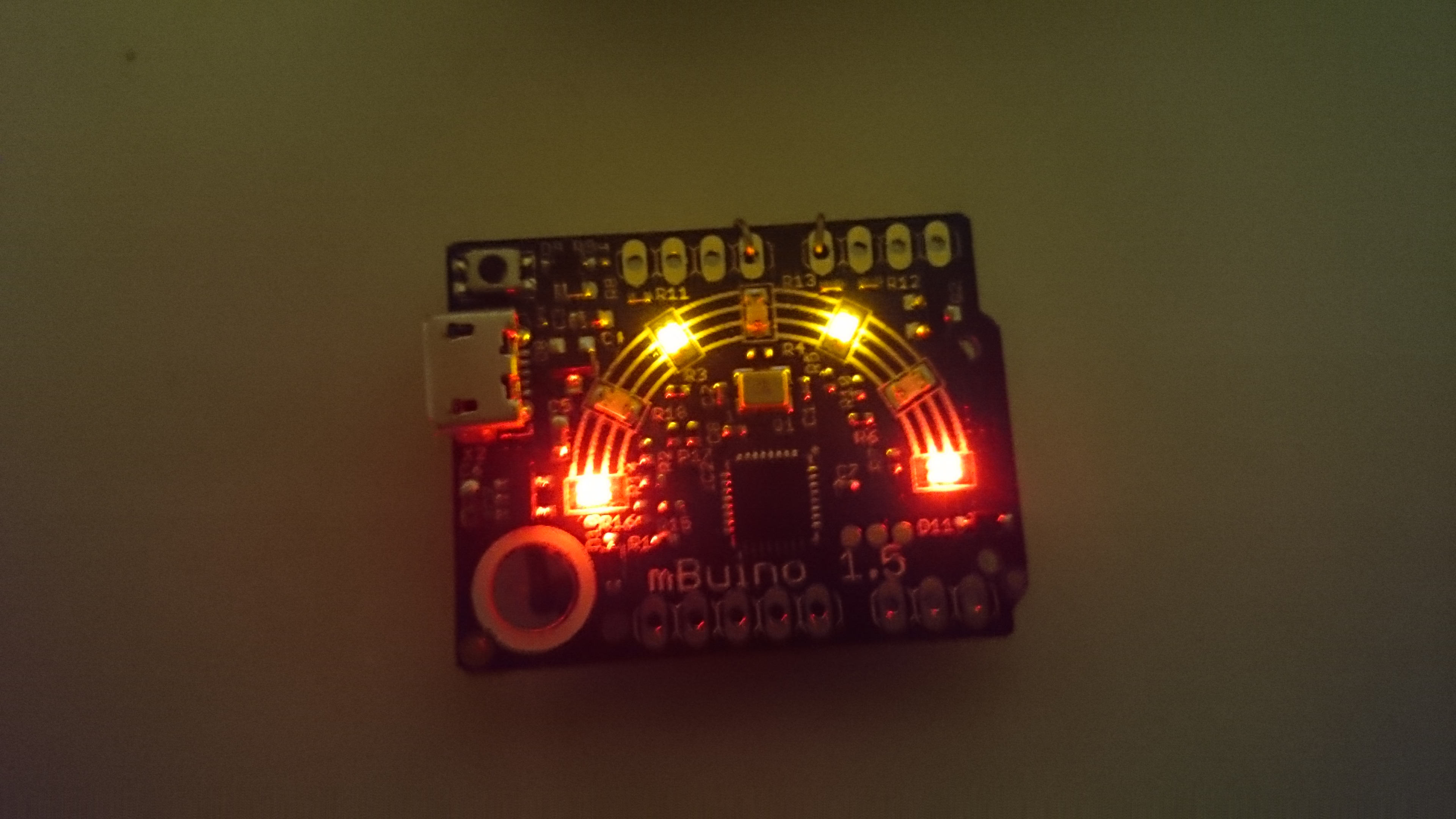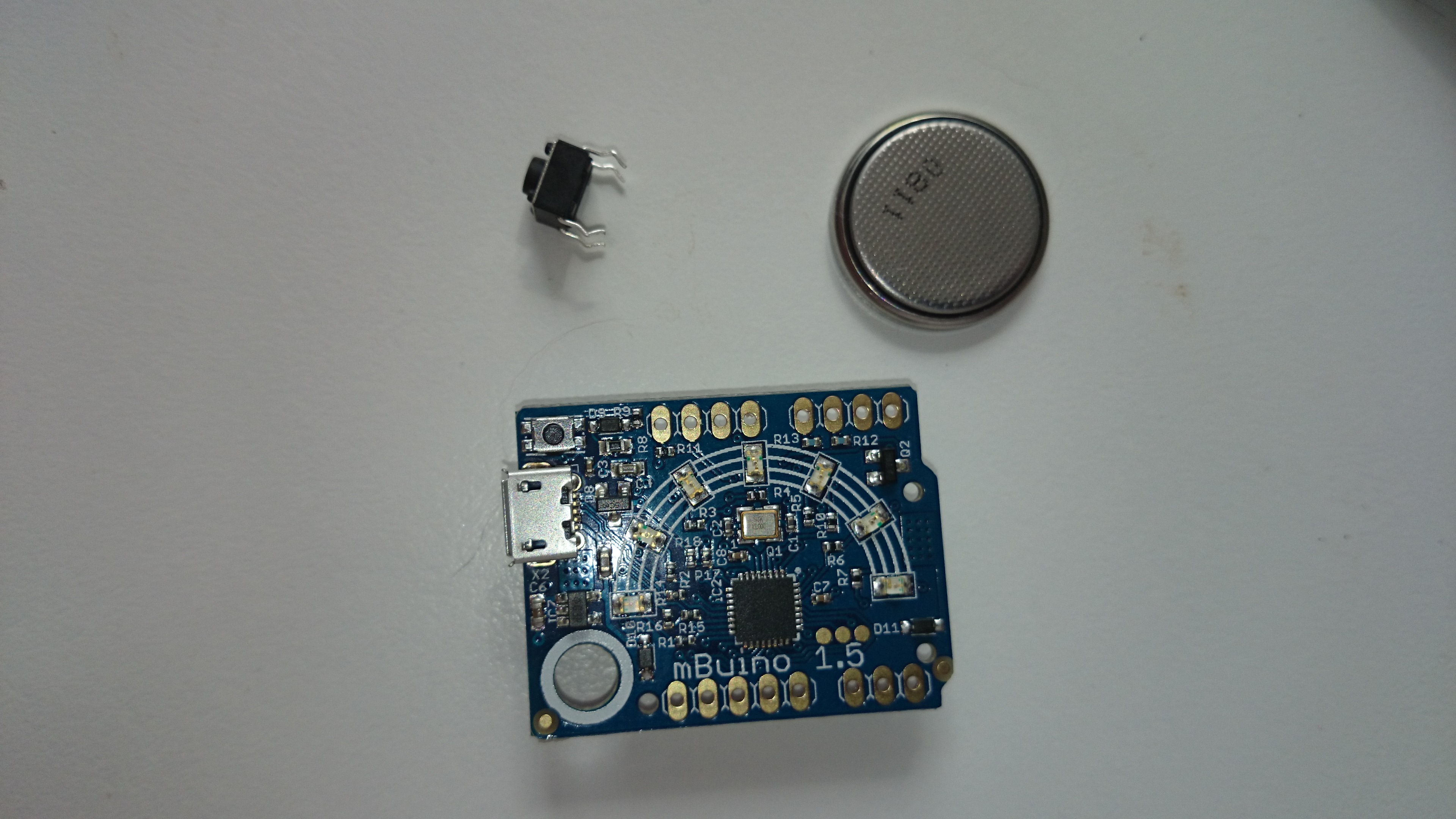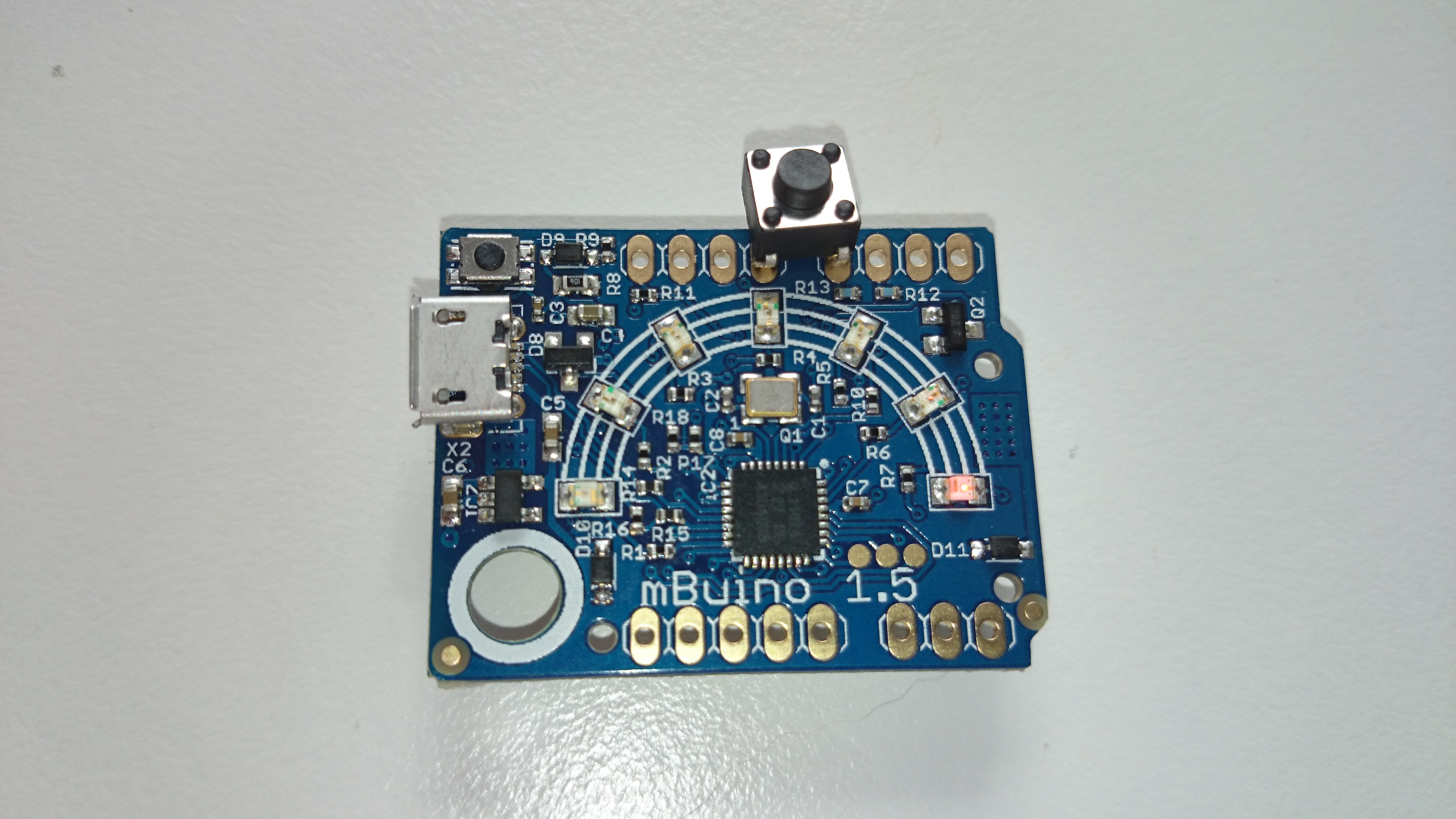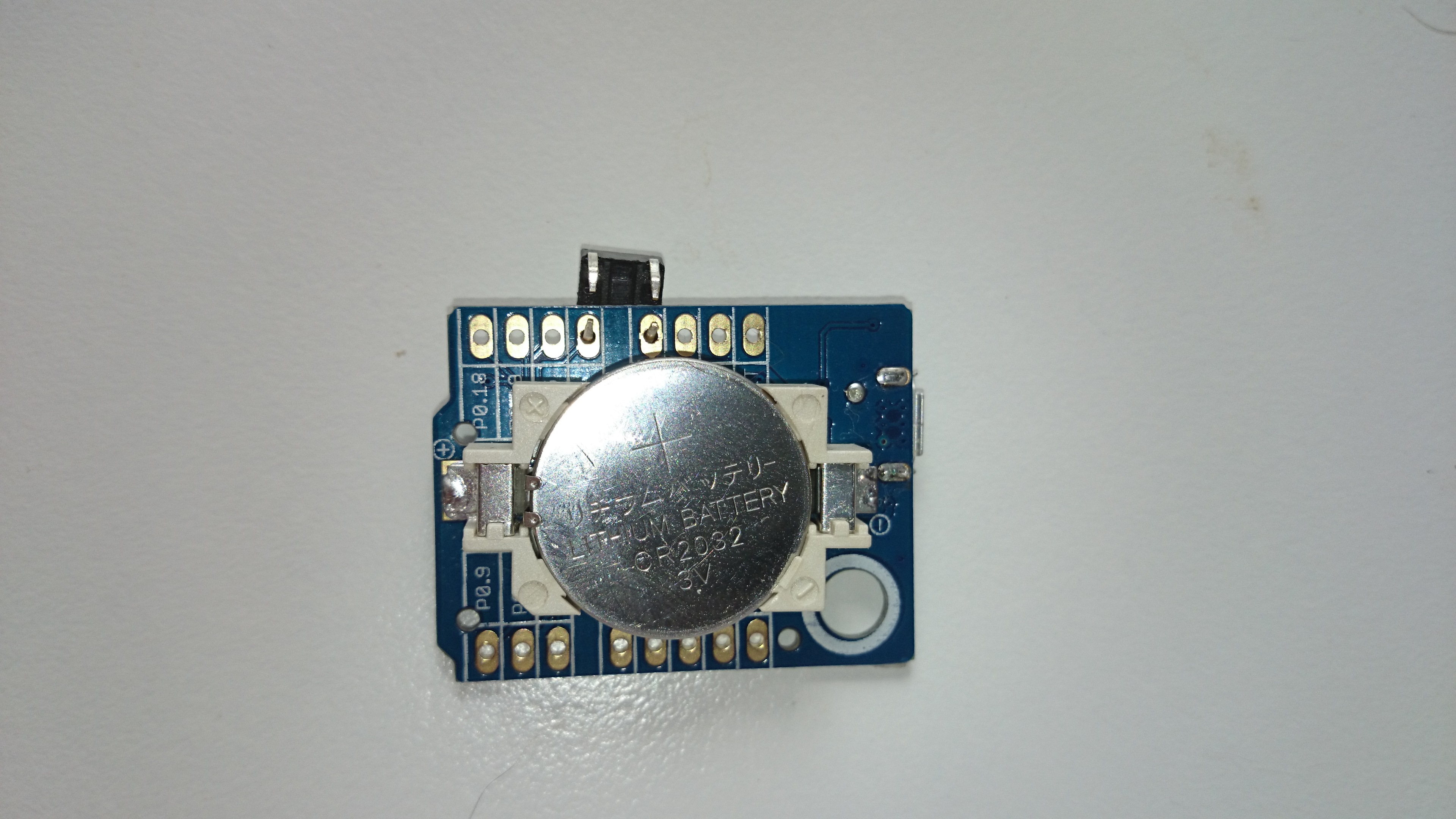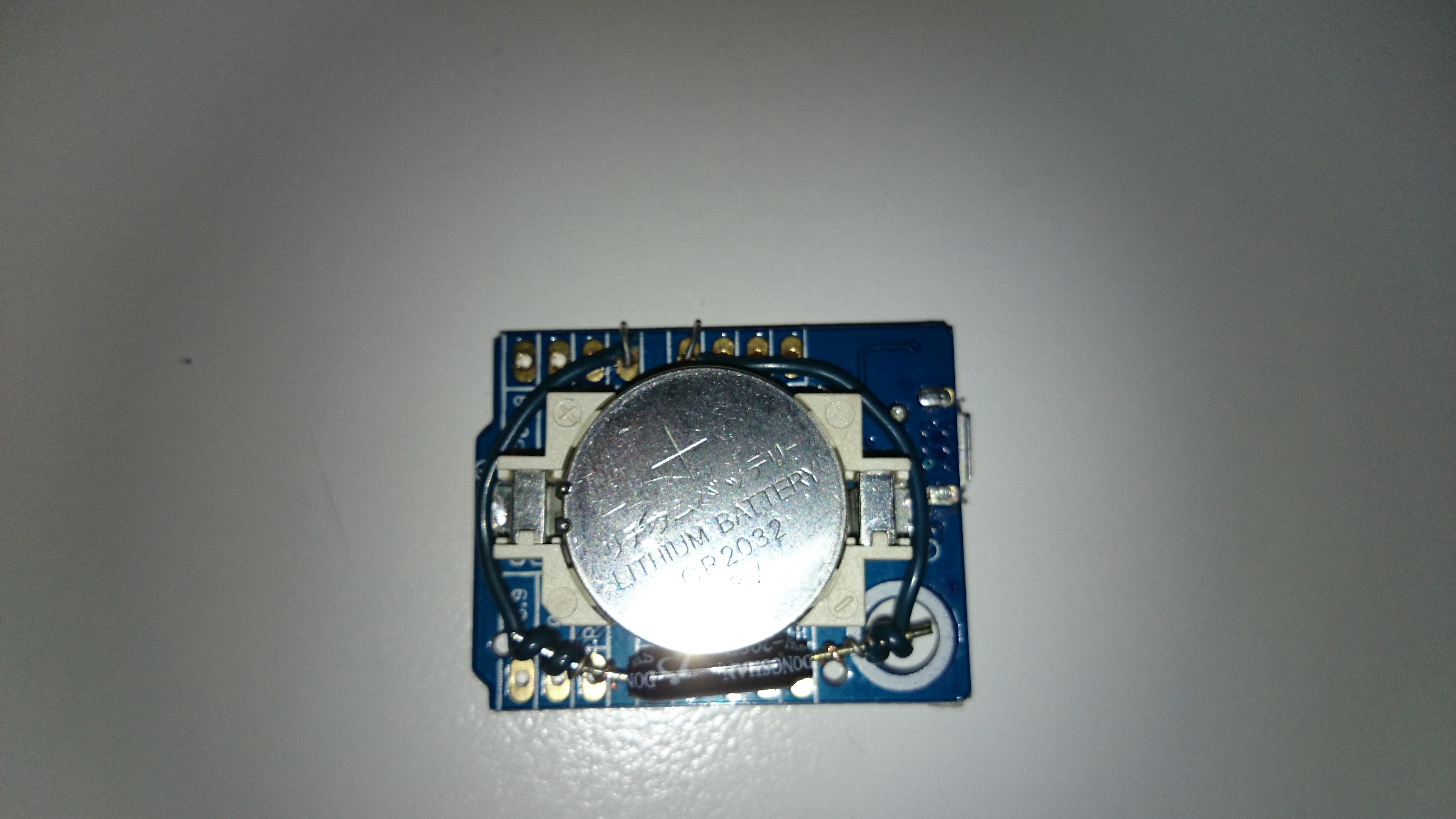Electronic dice application for the mBuino platform. Notes: The mBuino starts in Demo mode. In Demo mode the LEDs are lighted, showing sweeps and demo rolls. Connect a button or tilt-switch between P0.4 and GND. No soldering required! When the switch is triggered mBuino goes into Roll mode. In Roll mode mBuino starts with rapid flickering LEDs. Each subsequent switch trigger will perform a roll of the dice, of which the result is shown for ten seconds unless the switch is triggered for another roll. To preserve power, Power down mode is entered after inactivity in Demo mode or Roll mode. Press any button to revive.
Fork of mBuino_Dice by
mBuino_Dice
The hardware: No soldering required
As you can see in the picture gallery below, this is a very simple mBuino project, requiring only one extra component: a switch such as a push button or a tilt switch.
Push button
The push-button I used fits neatly between P0.4 and GND. By just bending the legs flat to the PCB, the button attached sturdy enough to make a usable connection.
Tilt switch
The tilt switch version is much more fun. No pushing, just a shake to roll the dice! In the tilt switch version two short wires were used to connect the switch. The wires were twisted around the legs of the tilt switch without any soldering! By adjusting the horizontal level of the switch you can make the dice react more sensitively to small movement.
For a production version, I would of course make it all a bit more durable by soldering the connections and using hot glue to keep everything in place. But going that route, I would also want to make a nicely fitting box, perhaps use other LEDs in a traditional dice-eye position and add an on-off switch...
Revision 3:52997a5f2fbc, committed 2014-09-08
- Comitter:
- maxint
- Date:
- Mon Sep 08 10:01:38 2014 +0000
- Parent:
- 2:0d311a6cfb96
- Child:
- 4:0c3a1b829d8c
- Commit message:
- 0.1.140908 Added deep sleep mode, explanatory comments, incorporated suggestions, improved randomness
Changed in this revision
| main.cpp | Show annotated file Show diff for this revision Revisions of this file |
--- a/main.cpp Mon Sep 01 18:59:39 2014 +0000
+++ b/main.cpp Mon Sep 08 10:01:38 2014 +0000
@@ -5,9 +5,12 @@
** Setup requirements: connect any type of switch between P0.4 and GND.
** On mBuino P0.4 is close to GND and the two pitch distance is exactly the same as a mini-switch!
**
-** 0.1.140901 Made for mBuino on mbed.org by maxint on 1-sep-2014
+** 0.1.140908 Added deep sleep mode after one iteration of demo or ten seconds of wating, credits: Andy A and Erik Olieman
+** Added explanatory comments and incorporated suggestion by Erik Olieman
+** Improved randomness as per suggestion of Andy A
+** 0.1.140901 First version mad for mBuino on mbed.org by maxint on 1-sep-2014
**
-** Feel free to use this code anyway you want, but please acknowledge my work by mentioning my name.
+** Feel free to use this code anyway you want, but please acknowledge my work by mentioning maxint as creator.
**
*/
@@ -15,10 +18,12 @@
#include "mbed.h"
DigitalOut LED[] = {(P0_7), (P0_8), (P0_2), (P0_20), (P1_19), (P0_17), (P0_23)};// declare 7 LEDs
-InterruptIn ActionButton = (P0_4); // declare the input for the button (or for other single switch, such as movement switch). On mBuino P0.4 is close to GND
-AnalogIn RandomIn = (P0_14); // use the random noise on this analog input to seed the random generator
+InterruptIn ActionButton(P0_4); // declare the input for the button (or for other single switch, such as movement switch). On mBuino P0.4 is close to GND
+AnalogIn RandomIn(P0_14); // use the random noise on this analog input to seed the random generator
+// Define the LED pattern of each dice number
+// Can be made more compact by using binary values instead of a nested array.
bool DicePattern[6][7]=
{
{0, 0, 0, 1, 0, 0, 0 },
@@ -29,11 +34,35 @@
{1, 1, 1, 0, 1, 1, 1 }
};
-float delayTime = .05;
+/*
+// TODO: Suggestion by Erik Olieman: alternatively BusOut can be used to combine all used pins in one bus that can be set using a single write
+BusOut LEDS(P0_7, P0_8, P0_2, P0_20, P1_19, P0_17, P0_23);
+char byteDice[6]=
+{
+0x08, // 0B00001000
+0x22, // 0B00100010
+0x2A, // 0B00101010
+0x55, // 0B01010101
+0x5D, // 0B01011101
+0x77 // 0B01110111
+};
+*/
+Timer tWait; // time used for tickcounts
+
+void myDeepSleep()
+{ // Go into deep sleep to safe power. Use onboard or off-board interrupt triggered button to revive
+ // see http://mbed.org/forum/repo-52552-mBuino_low_power_led_flasher-community/topic/5130/
+ LPC_PMU->PCON = 0x1;
+ SCB->SCR |= SCB_SCR_SLEEPDEEP_Msk;
+ LPC_SYSCON->PDAWAKECFG &= 0xFFFFF800;
+ __WFI();
+}
+
void SwitchAllLeds(bool fOn)
{ // switch all leds on or off
+ // Suggestion by Erik Olieman: alternatively BusOut can be used to combine all used pins in one bus that can be set using a single write
for(int x = 0; x < 7; x++)
{
LED[x] = fOn?1:0; // turn on or off
@@ -49,7 +78,7 @@
}
void BlinkOneLed(int nLed=0, float flDelayOn=0.2, float flDelayOff=0.2)
-{
+{ // blink just one led once, for the specified time
LED[nLed] = 1; // turn on
wait(flDelayOn); // delay
@@ -97,9 +126,12 @@
wait(flDelayOff);
}
-int RollDice(int nRolls=10, int nBlinks=2, float flDelayRoll=0.2)
+int RollDice(int nRolls=10, int nBlinks=2, float flDelayRoll=0.15)
{ // roll the dice and show the outcome value
int nDiceValue;
+
+ // improve randomness: seed the random generator with the background noise of an analog input combined with passed time at user triggered moment
+ srand(RandomIn.read_u16()+tWait.read_us());
// first roll the dice
for(int n=0; n<nRolls; n++)
@@ -112,7 +144,7 @@
nDiceValue=rand()%6+1;
for(int n=0; n<nBlinks; n++)
BlinkDiceLed(nDiceValue, flDelayRoll, 0);
- BlinkDiceLed(nDiceValue, true);
+ SwitchDiceLed(nDiceValue, true); // return while keeping dice led's on
return(nDiceValue);
}
@@ -130,6 +162,7 @@
srand(RandomIn.read_u16()); // seed the random generator with the background noise of an analog input
ActionButton.fall(interruptButtonPressed); // using the fall requires the button to be unpressed before the interrupt is triggered again
+ tWait.start(); // start the timer
}
void loop(void)
@@ -177,27 +210,35 @@
if(!fButtonPressed)
wait(1);
+
+ if(!fButtonPressed)
+ myDeepSleep(); // enter deep sleep after one demo iteration
}
else
{ // demo mode is ended, roll the dice upon each button press
fDemoDone=true;
fButtonPressed=false;
+ unsigned uTickStop=tWait.read_ms()+10000;
while(!fButtonPressed)
{ // flash the LEDS to show we wait for a roll call
SweepAllLeds(true, 0.01);
SweepAllLeds(false, 0.01);
+
+ if(!fButtonPressed && tWait.read_ms()>uTickStop)
+ myDeepSleep(); // enter deep sleep when waited for more than 10 seconds without button pressed
}
fButtonPressed=false;
-
- Timer tWait;
+ // roll the dice and show the outcome while waiting max. 10 seconds
int nDiceValue=RollDice();
wait(1);
- tWait.start();
fButtonPressed=false;
- while(!fButtonPressed && tWait.read_ms()<10000)
- BlinkDiceLed(nDiceValue, 0.2, 0.01); // hmmmm, something switched off the leds after the wait? Strange, let's just blink them...
+
+ uTickStop=tWait.read_ms()+10000;
+ while(!fButtonPressed && tWait.read_ms()<uTickStop)
+ //wait(0.1);
+ BlinkDiceLed(nDiceValue, 0.2, 0.01); // to indicate waiting for a new roll, blink the thrown dice value...
SwitchAllLeds(false);
}
}

